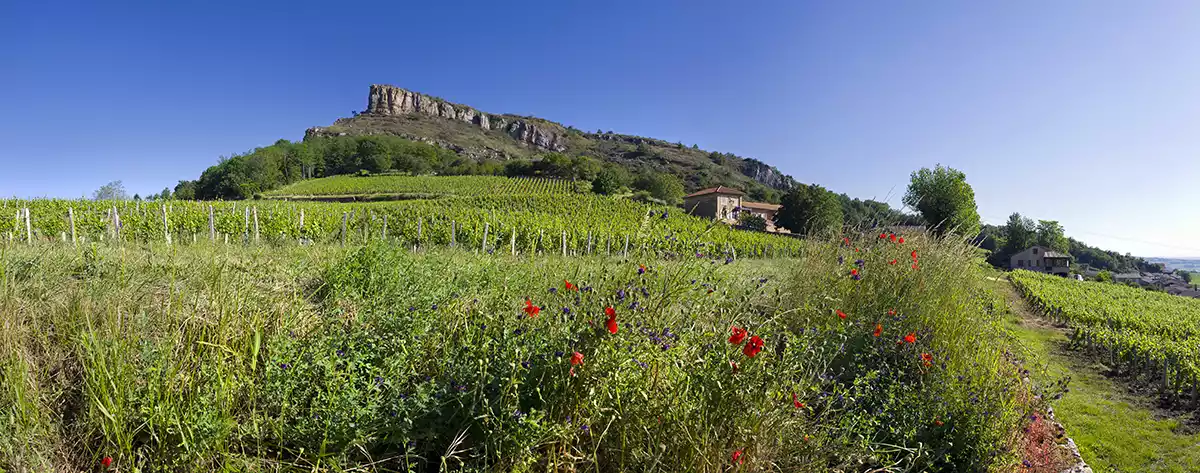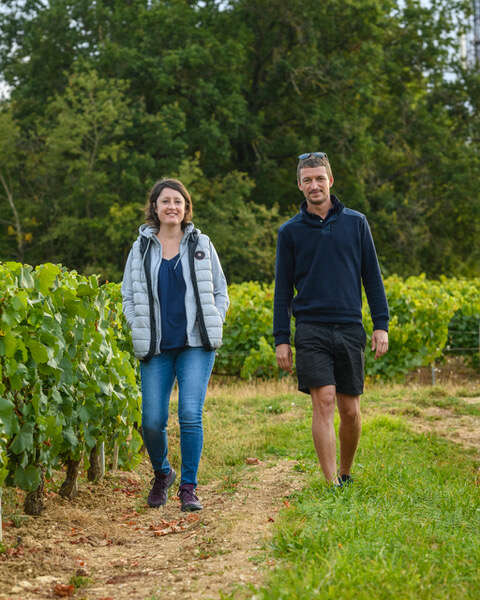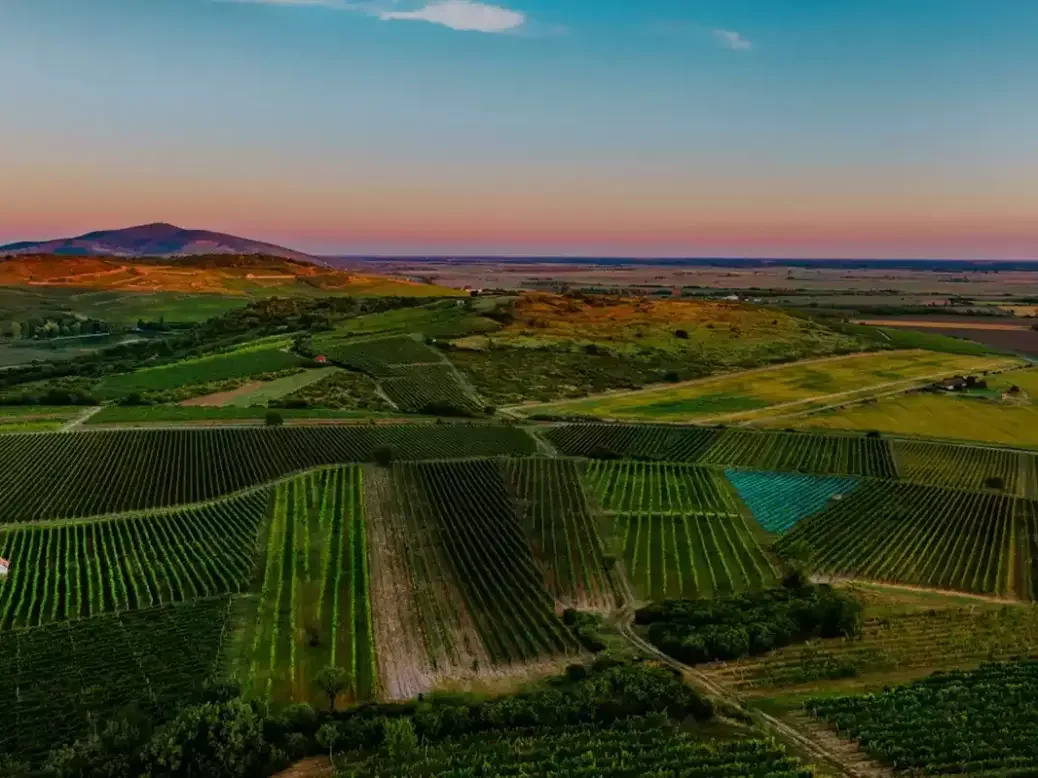
In the second part of her report from Tokaj, Sarah Marsh MW gets to grips with some of the most promising terroirs for making dry wines.
Tokaj: Drying up or drying out?
Tokaj and Tarcal
The village of Tokaj lies on the southern end of the region beside the confluence of the Bodrog and Tisza Rivers which create the humid conditions necessary for botrytis. Dry wines come from vineyards above the fog zone. The designated areas for vineyards encircle the tops of volcanos in Tokaj offering multiple aspects. Not only do Tokaj and Tarcal villages have the lion’s share of classy single vineyards, snaffling 31of the top 50 (largely in Tarcal), they also have a standalone soil which produces a distinctive style of wine.
Here the top soil is loess, a fine mineral-rich sediment ground from rock by glacial movement. Windblown from the Hungarian plain, this lies 20m (66ft) deep on the far Tarcal side of the hill. Compared with wine from the majority of villages, where the vines are rooted into volcanic rock, Tokaj and Tarcal wines have a more delicate structure. They are lighter bodied and have slightly lower acidity making them friendly and quite accessible in youth.
Tokaj-Hétszőlő, a medium-sized estate of 55ha (136 acres) under the same ownership as Cos d’Estournel, produces a good example of the Tokaj style from His Garai, a second-class 15ha (37 acres) monopole. Furmint 2021 is finely textured and refined.
Around the other side of the hill, from the deep loess vineyard of Lónyai in Tarcal village, the producer Basilicus produces a straight, precisely edged, high-wired, and elegant Furmint in 2019 (a very good vintage, not as intense as 2021, but nor as high in alcohol and acidity) with an attractively dry finish, while Kikelet, which has six single vineyards in Tarcal, make Hárslevelű in Lónyai from a higher windswept section of the vineyard. The 2021 is tightly furled and quivers with tension. These wines neatly express the typicity of the terroir in the two two villages with loess soil.
Mád village
But my attention was riveted by the village of Mád, which lies adjacent to Tarcal to the north. Here the vineyards have the volcanic bedrock and clay topsoil typical of the region. Rhyolite is mixed in different proportions with andesite, zeolite, and perlite; and in some places quartz and in others tufa. This volcanic cocktail produces wines more firmly structured than Tokaj and Tarcal. Among all the wines I tried from different villages, Mad’s seemed denser and more compact, and particularly on the East side of the village, fuller and richer. Over the past decade the potential of Mad’s vineyards has attracted some of the most skilful winemakers. It’s a hotbed of young talent and great terroir.
So after three days of tastings and visits, covering all styles with Mád wines among them, I broke away to stay in Mád for a couple of days. Mád’s wine community tends to be a bit ahead of the curve. Even before demarcation, viticulture and laborers’ earnings were regulated. Just recently, and with effect from the 2023 vintage, the Mád Circle for the Protection of Origin has drawn up a code, independent of the regional authority, with tighter regulations for viticultural practices and origin including such things as maximum yields, age of vine, and density of planting. As for single vineyards, Mád’s regulations demand 100 percent single-varietal Furmint or Hárslevelű which must be matured for six months in barrel. Those who comply may use the Mád Origin Control trademarks of MOC and MDOC on their labels.
But for the moment I came across only one producer making a Mád village wine. Dénes Szarka was a sommelier before opening a small guesthouse in 2005. He started by making wines for his guests and in 2020 opened a bistro (well worth a visit). He’s a smallish producer making 8,000 bottles (70 percent dry) from 3ha (7.5 acres) across five single vineyards in Mád. His 2021 Mád village wine, a blend of three vineyards, shows the breadth, rich texture, and firm cold cut of acidity typical of Mád’s wines.
It’s strange and rather a missed opportunity that few producers make use of their village-level appellation. Many have estate wines, often blended from vineyards within one village, which are labelled as regional wine. Tarcal has a sort of co-operative village wine (Mád used to, but no longer) to which producers contribute grapes for a village blend, but the objective is to promote tourism at wine events and festivals within their village.
As I tend to view things from a Burgundian perceptive, it seems to me that if producers want to strengthen the identity of their village with serious consumers, especially in those in the export market, a village appellation wine is an essential stepping stone along the terroir pathway, from an introductory and well priced regional wine to an expensive single vineyard wine.
It’s easy to get caught up in the history and economics of the region, useful for context, but now let’s dig into those single vineyards (dülos) of Mád.
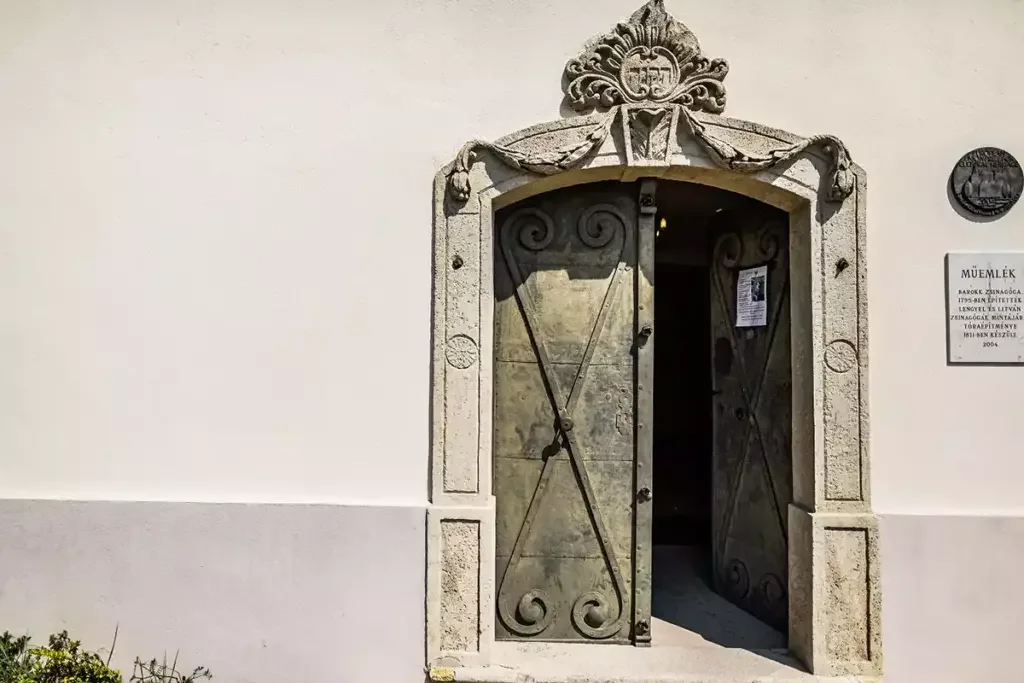
Szent Tamás (St-Thomas) vineyard
As I stood on the rocky crest of a 260m (850ft) hill in the first-class vineyard of Szent Tamás (St-Thomas) and turned to look around me, the vines draped over slopes of many aspects.
Szent Tamás lies on the east side of Mád village rising immediately from the outer fringe of houses. The clay soil is noticeably red, two meters deep at the foot and progressively thinner and stony to the top. Beneath this is a bedrock of rhyolite, quartz, and pumice. Szent Tamás, a large vineyard of 75ha (185 acres), was first mentioned in 1611.
As I was able try wine from different producers, a general profile emerged. Szent Tamás is firmly structured, but svelte. I find Szent Tamás has lithe muscularity. Firm acidity is enveloped within the wine. Layered, well defined, and contained, they stretch firmly and elegantly onto the finish. In 2021 they are powerful with an unsprung, reserved feel. Whatever the vintage they have the easy harmony, balance, and quiet confidence of wines of a top level terroir. Complex wine, Szent Tamás is Mád’s thoroughbred.
“I was afraid to make it; its reputation is so high,” remarked Kata Zsirai, Hungary’s Young Winemaker of the Year in 2018. She acquired a south-facing snippet of Szent Tamás in a recent land swap with Sauska, a large outfit in Mad at the forefront of quality sparkling-wine production. Zsirai Szent Tamás 2019 has toned muscularity.
Even in the hot 2022 vintage, Szent Tamás at Szepzy’s winery (tasted from barrel) was contained, intense, and layered with a cold cut of acidity and a quietly powerful finish.
This terroir makes wine to age. István Szepsy finds Szent Tamás goes through a flat period after five years, but comes back. Szepsy Szent Tamás 2020 showed good intensity and balance from this rather difficult cold and rainy vintage. Szepsy has dwarf and gnarled goblet vines on the cooler east-facing slope. Planted in 1957, this parcel was all but abandoned, until István Szepsy Senior revived it.
During the communist regime, parcels of bush vines on difficult-to-work slopes were of no interest to the state. Large Russian tractors could only operate on the flat between wide-spaced rows. Growers were permitted to keep and cultivate one hectare of vines, the fruit from which went to the state wineries. Thus some vineyards, such as this small parcel of Szent Tamás survived.
István Balassa, mentioned earlier, has an impressive overview of terroir from working with 1,000ha (2,500 acres) of vineyards for the former state winery Grand Tokaj. He also makes his own wines from a plethora of parcels, largely in Mád. “There is a high calcium carbonate content in Szent Tamás and in my opinion it is the most elegant terroir in Mád with rounded peach and length, but it needs two to four years in bottle to develop.” Bassala’s wines are on the richer side, “I like to wait for full ripeness,” he says.
Some producers have vines in a southerly subsection called Makovicza, which István Bassusa tells me has the highest potential in Szent Tamás for dry wine. I tasted a couple of Makovicza which showed tension, power and intensity. Pelle Pince make a Hárslevelű from this parcel and I wrote nothing about aromatics only of the structure, vigorous energy and length. Terroir stands out. It goes to show there should be subdivisions of vineyards to reflect the potential of the terroir.
I also liked Royal Tokaj’s elegant and intense Szent Tamás 2019 coming largely from the west-facing flank overlooking the village. Royal Tokaji are a big player in Mád with 57ha (140 acres) of their total 108ha (267 acres) in the village, largely in Szent Tamás, Betsek, Úrágya, and Nyúlászó. As has been well documented, this company was established in 1990 when 62 growers came together with overseas investors, overseen by Hugh Johnson, to restore the reputation and lost glory of Tokaj.
Betsek/Becsek vineyard
From my vantage point, turning to face roughly east, I overlooked the Mád basin. In this natural bowl lies the first-class 110ha (272 acres) vineyard of Betsek, first mentioned in 1600. Partially enshrouded in mist it was easy to appreciate the conditions here could be conducive for botrytis later in the year. While in the bare vineyards of late March, the soil was noticeably whiter (in the clear afternoon) than the red soil of Szent Tamás. There is a high level of tufa in Betsek’s rhyolite soil.
Betsek dry wines are fullish, certainly broad, notably generous, and possibly looser knit than Szent Tamás. Less lithe, more burly. They are richly textured and can appear quite creamy in comparison with wine made from other vineyards by the same producer. They are fruit forward and often spicy, although the latter is probably as much from the aromatic contribution of Hárslevelű, which is more popular than Furmint for making dry wine in Betsek. Szepsy says he doesn’t much like Betsek for dry wine as the alcohol can be too high. Hárslevelű reaches phenolic ripeness earlier than Furmint, so maybe others agree. Hárslevelű emphasizes Betsek’s open and expansive palate, attractively encased in aromatic white peach. Seen through Furmint, it’s a bit more firmly structured.
The freshness of Betsek wine is most noticeable on the finish where it is accompanied by a distinctive salty and piquant mineral tang. Bott Betsek Hárslevelű 2021 made by Judit Bodó has an attractive soft-flake saltiness on the finish.
At Holdvölgy, a Mád winery, but also the name of a Mád vineyard, I tasted six vintages of Harslevelu from Betsek. The 2012 is rather sumptuous, broad and glossy partly from some smart Seguin Moreau oak. With bottle age Betsek (2013 and 2009) slims down and focuses on its saline finish. Holdvölgy, which produces seven single-vineyard wines, confusingly doesn’t use the vineyard names on their labels. Betsek is called “Expression.”
All those making wine from Betsek spoke of the tufa. Balossa remarks, “The majority of parcels, within the 82ha [203 acres], are white rhyolite tufa and this is what gives the wines their velvet texture. There are also about 12ha [30 acres] of quartz which produces something more powerful and about 4ha [10 acres] of andesite which makes a more balletic style.” He mentioned the high concentration of clay minerals, which he says are responsible for the mineral bitterness on the finish of Betsek wines.
Even in Mád many slopes are uncultivated. Squinting, I could see the ghostly outlines of terraces abandoned to shrub. In the aftermath of phylloxera, during which 95 percent of vines in Tokaj were lost to the louse, the majority of terraced vineyards on steep slopes, many of which were cultivated 500 years ago, were simply not replanted. In its heyday Hungary was the fourth-largest wine producer in Europe after France, Italy, and Spain.
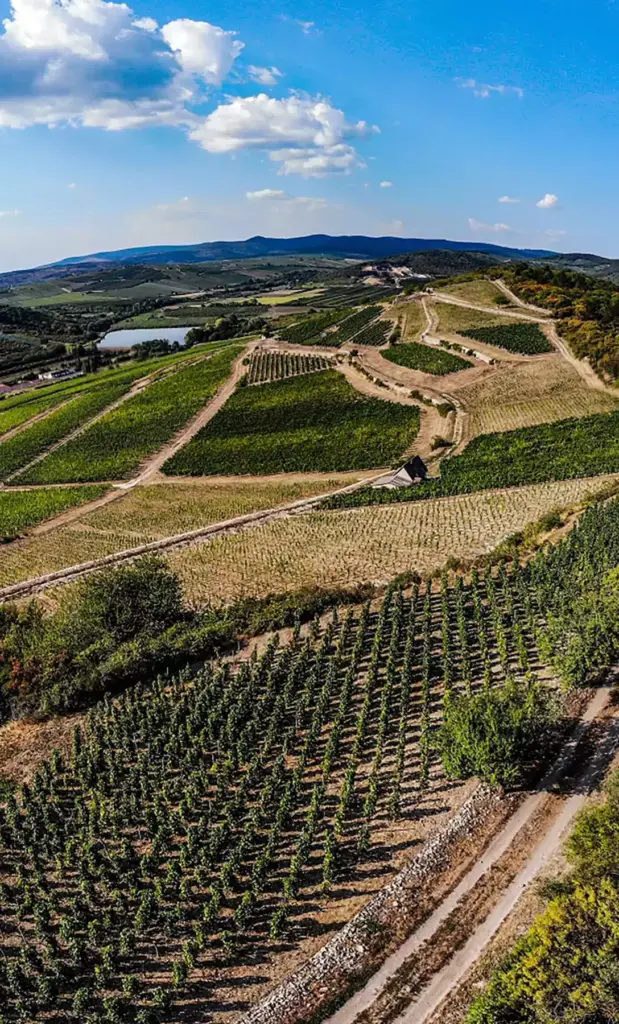
Király and Öreg Király vineyards
Betsek is skirted by other vineyards. Out of my sight line, on the far side of the hill of ghostly terraces, is Király or King’s vineyard, which was first mentioned in 1280. Recently it was officially divided into two sections. An upper part of 14.4ha (36 acres) called Öreg Király or Old King, which first made an appearance in 1664, was totally abandoned until Karoly Barta, someone with no previous experience in the wine trade, came along in and rescued it. Barta own half the vines plants in Öreg Király and Demetervin the other. Öreg scales the slope to 360m (1,180ft) of Király-hegy the highest hill in the Mad basin with much of the steep south-facing vineyard above the fog zone, although not entirely unaffected by botrytis as I tasted Öreg Király Aszú from Barta.
I tasted several vintages of Barta’s rich and concentrated dry wines from Öreg Király which display flashy energy and tension. The lower Király section of 40ha (100 acres) is essentially flat, divided from Betsek by a dirt track. Erzsebet estate make a softer broader wine from Király matured in French oak, which seems quite like Betsek.
Many ferment their higher-end dry wine in oak barrels with a small percentage of new. Holdvölgy age ‘Expression’ in French oak, as they feel French oak combines subtlety with Becsek’s salty finish, but most prefer 300-liter Hungarian barrels made with oak from the neighboring Zemplen mountains. This can be quite spicy and strong. Maybe that’s the whippet-thin oak itself or possibly cooperage skills playing catch up after communism. Szepsy are usual in using 100 percent new oak barrels (Hungarian), but their wines were not overly oaky. Perhaps the malolactic in barrel helps to integrate the oak.
The majority of producers strongly prefer not to make malolactic fermentation. They seem strangely concerned about lactic notes. It may be cultural since it’s not usual to have MLF in sweet wine, not least as the bacteria is deterred by sulphur. In dry Furmint wines it’s unlikely to happen naturally because of its low pH. On the issue of malolactic, Szepsy stands apart, as they do for many many things, including quality. István Szepsy comments “Not doing a malolactic fermentation is the biggest issue preventing the ageing of Furmint in bottle.” Since 2015 all his wines go through full malolactic. However, in contrast to most producers he doesn’t use any bâtonnage, arguing that the lees from Furmint have bitterness which he prefers to leave undisturbed.
Most producers do like to use bâtonnage. Balassa stirs every week, but nobody does a prolonged ageing. Whether in oak, stainless steel, terracotta, or ceramic élevage tends to be a few months over winter with bottling in late spring. At the end of March the serious 2022s were still in barrel. Six months of barrel age is now required to use the Mád single-vineyard MDOC trademark.
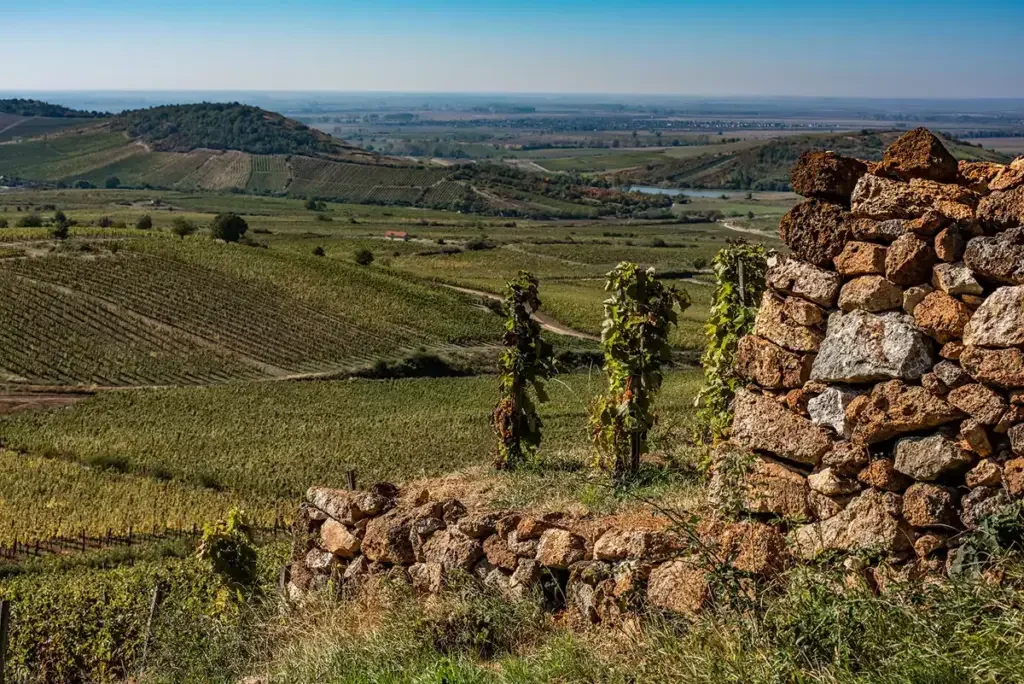
Nyúlászó vineyard
Adjacent to Szent Tamás, on a south-southwest-facing slope, lies Nyúlászó which means “a good place to hunt hares.” Among the four vineyards on which I have focused on this side of Mád village, Nyúlászó seems to have the roundest shape, but less intensity and depth than Szent Tamás and Betsek. Nyúlászó has some of the sweetness and richness of texture common to the vineyards on this side, but is not as velvet textured as Betsek can be.
Despite its warm aspect, those I tasted were not at all heavy. On the contrary, my impression is of more delicate and gentle wines with floral notes and sweet minerality on the finish. Holdvölgy make a dry muscat from Nyúlászó (called Intuition no. 2). The 2020 is not heavily scented and speaks more of the terroir than the grape variety. Although attractive, and rated a first-class vineyard for Aszú, I feel this vineyard is a cut beneath the others for dry wine.
Juharos
The vineyard of Juharos (from Juhar, the shepherds who grazed their sheep here) lies at 260m (640ft) at the northern end of the village beside Dénes Szarka’s guesthouse. Situated on top of the hill, Szarka describes it as a cold, windy parcel (rated third class, promoted to second) with yellow clay composed from rhyolite and quartz rock. Szarka has 1ha (2.4 acres) which was planted in 1956 with one of the communist clones which has small berries, loose bunches, and thick skins. T85 was the better of the two communist clones, while T92 has larger bunches for higher production. The two account for 80-90 percent of planting. There are higher-quality clones available for planting now.
I tasted four vintages of Furmint from Juharos. The profile was silky with a cut of acidity and cool mineral grip to finish. They had ginger and anise notes, and were higher toned and more herbal in colder vintages. Hárslevelű from Juharos had a similar profile.
It would be very interesting to taste other single-vineyard wines from Juharos, but many classified vineyards are partially planted and produced by just one or two producers or not at all. Kővágó, an historically famous vineyard in Mád, has been severely quarried, and awaits someone to rescue much of what remains. Szarka remarks “some of the highest potential sites have yet to be developed.”
West side of Mád
Now it’s time to look across the village to the other side of the valley where the vineyards overlooking the village face east-southeast. These were classified second class as they rarely get botrytis. Following the curve of the hill (the top of an old volcano) the exposure moves to south- and west-facing.
As a general observation, I found the wines on the west side of the village side straighter, trimmer, slimmer-textured, and more savory than the east side, which by comparison is more richly textured, rounder, or broader, with a sweeter sensation.
Úrágya Vineyard
Most famous of the west-side vineyards is Úrágya from which it was possible to taste examples from several producers. Úrágya, or “God’s bed” refers to the sun which sets behind the hill. The 70ha (173 acres) vineyard curves from facing south east to southwest. I found the wines straight, crisp, with well-defined edges. They are salty, bitter/pithy, or more floral, with cool sappy minerality. But there is more variation than in Betsek and Szent Tamás. Some are lighter, pretty, and more floral while Szepsy’s Úrágya 63 (which coincidentally refers to the parcel number and their oldest vines) is the richest and fullest of those I tried. Nevertheless it focuses into a cold and savory finish. Szepsy’s first vintage Uragya 2003, from younger vines, is slim with intriguing butter-mint aromas and flavors with a salty tang to finish.
Royal Tokaj’s Úrágya 2021 from Furmint in a west-facing parcel is a lively, layered wine with plenty of tension. The fresh acidity knocks the 14% alcohol into touch. While Fukeley’s Úrágya 2021 made with Hárslevelű, showed more of the spicy character of Hárslevelű than those from vineyards on the east side, perhaps because the style is lighter and slimmer on this side.
Urban Vineyard
A vineyard rated just second in the historical classification for Azsú, Urban makes a cracking dry wine from Szepsy. The Urban 73 is wine of serious austerity, which makes the savory Úrágya look succulent by comparison. The profile is straight, well-defined, mouth-puckeringly savory with green garden herbs on the aroma and no lack of tension.
Szepsy explains “the key is the clay minerals, which are like a powder. Hydro-thermic activity has disintegrated the rocks, changing their structure to become looser and less compact. This clay mineral powder has an important water-holding capacity and is found in concentrated pockets throughout the vineyards.”
These pockets were initially discovered by digging 20m (66ft) shafts in the vineyards, but are now found through gamma-ray scanning. The pockets of clay powder correspond to those parcels within vineyards most reliable for producing Azsú. Szepsy emphasizes the importance of the water retained in the powder used by the vine during the lengthly process of berry shrivelling. Apparently Betsek has many such parcels, although there are also concentrated pockets in vineyards rarely affected by botrytis and Urban is among them.
So it seems a combination of microclimate, the all important fog, in conjunction with the clay minerals is required to create the ideal conditions for botrytis and its successful development to produce Azsú berries. But what does this mean for a normal harvest of fresh berries?
Szepsy suggests the clay powder is responsible for the strong minerality of certain wines including Urban. (Vines cannot extract minerality from the soil or rock, but they can absorb minerals in solution, feasibly from a moisture-retentive mineral-rich clay powder, which may well give a sensation of minerality.) To reinforce his point, Szepsy took a rock and smashed it with another to expose the white seam of material, which it seems may hold the key to the sappy-saline character of Tokaj’s volcanic wines.
While I was admiring the old vines, Szepsy described the effort required to restore this abandoned vineyard, which was planted in 1938. From these old vines he has made a selection of material which is planted in a new section of the vineyard just up slope. Impressively steep, it’s no mean feat to create a vineyard on this slope. But Maison aux Pois are doing just that on a 2ha (5 acres) parcel. Szepsy estimates the cost of preparing the land, most significantly creating the terraces, and planting the vines at circa €2 million per hectare. At present, Maison aux Pois buy fruit from the only other grower in Urban, but it’s exciting to think that there will be more wine from this vineyard in coming years. Moreover, it’s promising for the village, and encouraging for the Tokaj wine trade in general, that substantial investment is poured into vineyards destined to make premium dry wine. No one would invest that much cash without the wherewithal to market it effectively, which is good news for everyone.
Középhegy vineyard
Continuing around the hill in a westerly direction from Uragya lies the vineyard of Középhegy. Although there seem to be quite a lot of new planting on this side of the village, I tasted only one example Középhegy, and Holdvölgy above it, so most wine must disappear into blends.
In Középhegy, buffeted by a cold wind, I tasted Zsirai Középhegy Furmint 2019 with Kata Zsirai. She says it’s her coolest vineyard, despite the more southerly exposure. When I first tasted this wine in London, I’d been impressed by its compact and taut structure. And it’s rated third class. Kozephegy is both concentrated and austere; an aloof wine which will take time to unfold. It makes a sharp contrast with Zsirai’s Betsek (one of the few Furmint I tasted from this vineyard), which is more welcoming, creamier and fuller.
Tállya village
Many producers from neighbouring villages will have a smidgen of land in Mád. Mád’s popularity has benefited Tállya village as investors look for cheaper land to develop. The style of the wines from Tállya, with its andesite soil, is similar to Mád, but a touch less rich. It’s a little cooler and the style is a bit narrower and briskly crisp, so more like the vineyards on the western side of Mád village than the east.
Szűcs Pincészet Furmint 2019, from from the higher altitude vineyard of Hasznos (250m [820ft]) in Tállya, is a good example. It is straight, savory, and salty. A brisk wine with miso on the finish. It is aged in stainless steel and has just 0.9 g/l residual sugar which does nothing to hide the zippy style of Tállya wines.
Any assessment of terroir is made though the lens of winemaking. I’ve mentioned malo, bâtonnage, and barrel-ageing preferences in Tokaj, but the most striking aspect is residual sugar. With very few exceptions dry wines are rounded off with some residual sugar. 6-8g/l is typical to balance the high acidity of Furmint and 4 or 5g/l for Hárslevelű.
Residual sugar is detectable above 2 g/l. A wine qualifies as dry in Hungary when residual sugar is below 4 g/l, but can be as much as 9 g/l, where the difference between total acidity in tartaric acid (g/l) and residual sugar are not greater than 2 grams. So a wine with 9 g/l residual sugar would be considered dry if it has an acidity of 7 g/l.
Tasting a few examples with punchy acidity and residual sugar below 2 g/l from Royal Tokaji, Szepsy, and Basilicus, I don’t see the need.
Sufficient sweetness, or rather an impression of it, is provided by the “sweetness” of oak and/or the textural creaminess of bâtonnage. However, in a culture of sweet wine, steely dry seems to create anxiety.
Is it cultural? Winemaker Judit Bodó argues Furmint doesn’t ferment all its sugar and she does not want to add yeast. However most producers admit they look to sugar for balance. Problem is, undisclosed residual sugar is confusing for the consumer. I gave a glass of dry Tokaji to my son to taste. “It’s sweet,” was his surprised comment (3.4 g/l) “but I like it.” In some markets, including the UK, an off-dry style may have connotations of cheap wine. Consumers may stumble which would be a shame for I am impressed with the overall quality of Tokaj’s dry wine. But dry means dry.
And so as I stood in Szent Tamás’s vineyard on the last morning enjoying some welcome sunshine, I found myself hoping that more producers would dare to go dry, truly dry that is, to allow the purest expression of terroir from the vineyards which cloaked the slopes around me.

